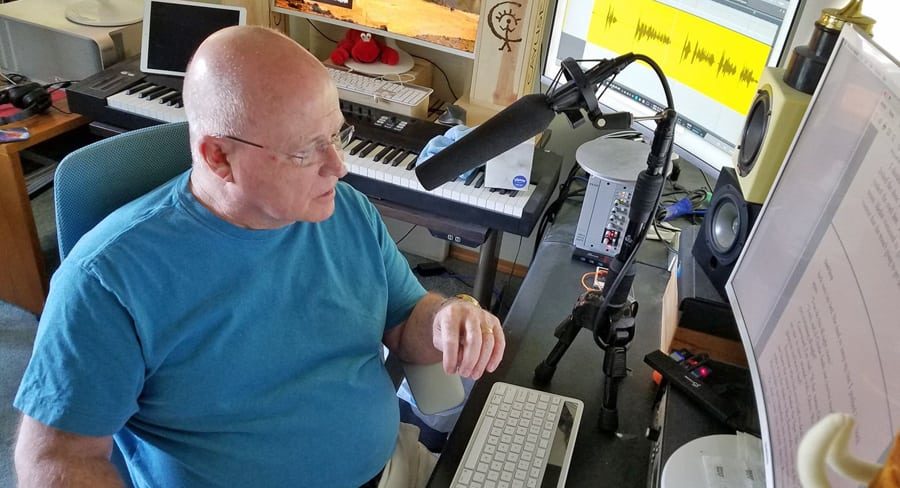
Home » Libraries note increase in digital downloads as audiobook popularity grows
Libraries note increase in digital downloads as audiobook popularity grows

September 13, 2018
Nearly one in five Americans now listen to audiobooks.
That’s because smartphones have helped usher in a new way for consumers to digest books, and audio has quickly become the fastest growing format in the publishing industry.
That’s according an Audio Publishers Association’s May 2017 survey.
Despite the surge in popularity of audiobooks, voiced books have been around for almost a century. In the 1930s, the American Foundation for the Blind and the Library of Congress Book for the Blind program established the Talking Book Program. The first recordings included parts of The Bible, The Declaration of Independence and Shakespeare’s plays. By 1985, there were more than 20 audiobook publishers in operation, but their popularity had yet to take off.
Charles Kahlenberg of Richland began narrating audiobooks in the 1990s while working as an actor in Los Angeles. His first project was a series on American presidents he voiced under the pseudonym, Ira Claffey.
“That was when books came out on cassette — a book called ‘The American Century.’ By the time I finished voicing it, you needed a steamer trunk to haul it around,” he said, referencing the number of cassettes required to create the audiobook version of the book.
By 2003, CDs replaced cassettes as the preferred way to listen to audiobooks. Five years later, digital downloads surpassed CDs as the most sought-after format — but some genres did better than others.
“When I started (narrating) I took what I could get to see how the process worked. Then I did a couple of religious books and I found that the market for that is very limited,” Kahlenberg said. “Then I thought, ‘I’m going to look at the actual statistics.’ At that time, thrillers were on top.”
The APA still lists thrillers among the top digital downloads. Mysteries, suspense and popular fiction — such as New York Times bestsellers — make the list as well. Biographies and classics also stay in demand.
In 2017, there were 50,937 new audio titles reported to the APA. Net downloaded audio revenues increased 28.8 percent in 2017 over the previous year. And there’s no reason to believe that number will slow anytime soon.
Kahlenberg said he’s currently booked through February with seven audiobooks in the pipeline.
Each book he works on takes about 20 to 25 hours of time, which includes editing the final product before sending it to the publisher. Rather than charging a fixed fee for his services as some narrators do, Kahlenberg said he prefers to collect royalties based on individual sales of books he’s voiced.
“And that means I have sweat equity in every book I narrate. I look at it as a basket of stocks. Some of them stink and you don’t get much of a payday, and sometimes you do. It’s not a whole lot of money when you start out, but as your basket gets bigger, you make more money,” he said.
Mid-Columbia Libraries’ Prosser branch supervisor, Katy McLaughlin, believes people are attracted to audiobooks because the professional quality oftentimes surpasses many podcasts, and books provide the allure of self-improvement that listening to music can lack.
“The stigma of listening instead of reading has lessened, particularly as the understanding and identification of reading disabilities has grown,” McLaughlin said. “The industry is also proactively responding to digital demand, so listeners are more likely to find something of interest than they were even 10 years ago, which reinforces their loyalty to the format.”
So who’s listening to audiobooks?
According to the APA, 32 percent of audiobooks are consumed by travelers or those commuting to and from work — but it’s not just a medium for people on the go. Thirty-four percent reported listening to audiobooks while relaxing at home. Another 17 percent listened while exercising, and the same number reported listening to them while cooking or crafting.
Even the demographic varies with the largest listening base — a reported 28 percent — ranging between 30 and 44 years old. According to the APA, the second largest group of listeners is between 18 and 29 years old and accounts for 24 percent.
Richland Public Library Manager Leslie Campbell Hime said media use for those 18 and older has increased a half-hour a week since 2017. She said while smartphone and tablet use still trails television and radio use, the library anticipates those numbers likely will reverse as additional digital content is made available.
“We have brought Hoopla to the Tri-Cities, which is absolutely for (Richland Public Library) card holders and allows users to download or stream digital content from a catalog of over 60,000 audiobooks and over 260,000 e-books,” Campbell Hime said. “This plentitude is necessary as our audiobook use has increased 13 percent and e-book use has increased 17 percent from 2017. Audiobooks, however, outstrip e-books in popularity as people demonstrate their preference to listen rather than read books.”
Campbell Hime isn’t sure what the attraction is to audiobooks, but expects the trend to continue and intensify as the library adds nearly 100 unique users to the library’s digital platform each month.
“Perhaps it harkens back to the days or yore when we told stories around the fire,” she said, “or maybe it is simply a progression like the coming of sound to cinema where it complemented the image. But now audio can bear the full weight of meaning, thereby freeing us from our anchoring to the printed word.”
Local News Science & Technology
KEYWORDS september 2018





